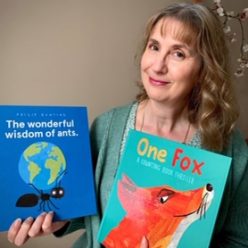Illustrated by the authors

Published by Candlewick Studio, 2017
This is a creative picture book that explores the idea of being inside and being outside. You would think that this is a straightforward concept, but the illustrations are thought provoking, making the reader reassess their perspective and really look at the images to make sense of what they are seeing.
The book itself is oversized and wordless. Each double page spread has an image on the left that illustrates an interior, the opposing page places that interior image in its wider outside context.
My favourite double page spread shows a four-poster bed, with pillows scattered on the floor, and torn curtains. Some of the torn curtains have been made into a rope that is dangling outside a narrow window. All this is illustrated on the left-hand page. On the right-hand page, we see a castle nestled on a hilltop, pennants waving in the breeze, surrounded by mountains and a river. At first, you wonder how the images are connected but, looking closer, there is the curtain-rope dangling out of a high window in the castle, unnoticed by a guard. In the meandering yellow river below, a small maiden with long flowing golden hair is wading through the water to reach the bank on the other side. Yes, it’s a snapshot of Rapunzel making her escape and without a prince to save her!
There are many other cleverly illustrated images: the chaos of a cabin inside a yacht that is navigating rough ocean waves; a figure in a tent warming his hands by a fire inside the belly of a whale; a driver in a cab at the head of a long road-train winding its way through a barren landscape; the vibrating heart of a person who is bungee-jumping off a very tall bridge. In the final image, there is an old man looking out of the window at the night sky from inside his house. On the page opposite, you can see that only one house in a row of many houses has a light shining in the window. It must be his house and his light we are seeing, a silent viewer of the vast inky sky while everyone else sleeps.
Without written words to navigate the images, there is a lot to talk about! Not only is the reader encouraged to pay attention to the details in the illustrations, but they are also required to understand the connection between the images. This introduces the concepts of perspective and opposites, as well as narrative comprehension, so important for reading as children progress to chapter books and longer stories.
I can highly recommend this picture book for children 4-8 years and below are more suggestions for picture books which focus on the theme of opposites:







by Petr Horacek


by David A. Carter


by P.D. Eastman

by Lucy Cousins

by Britta Teckentrup

by Lola Schaefer
Illustrated by Barbara Bash

by Mick Inkpen

by Mo Willems





























